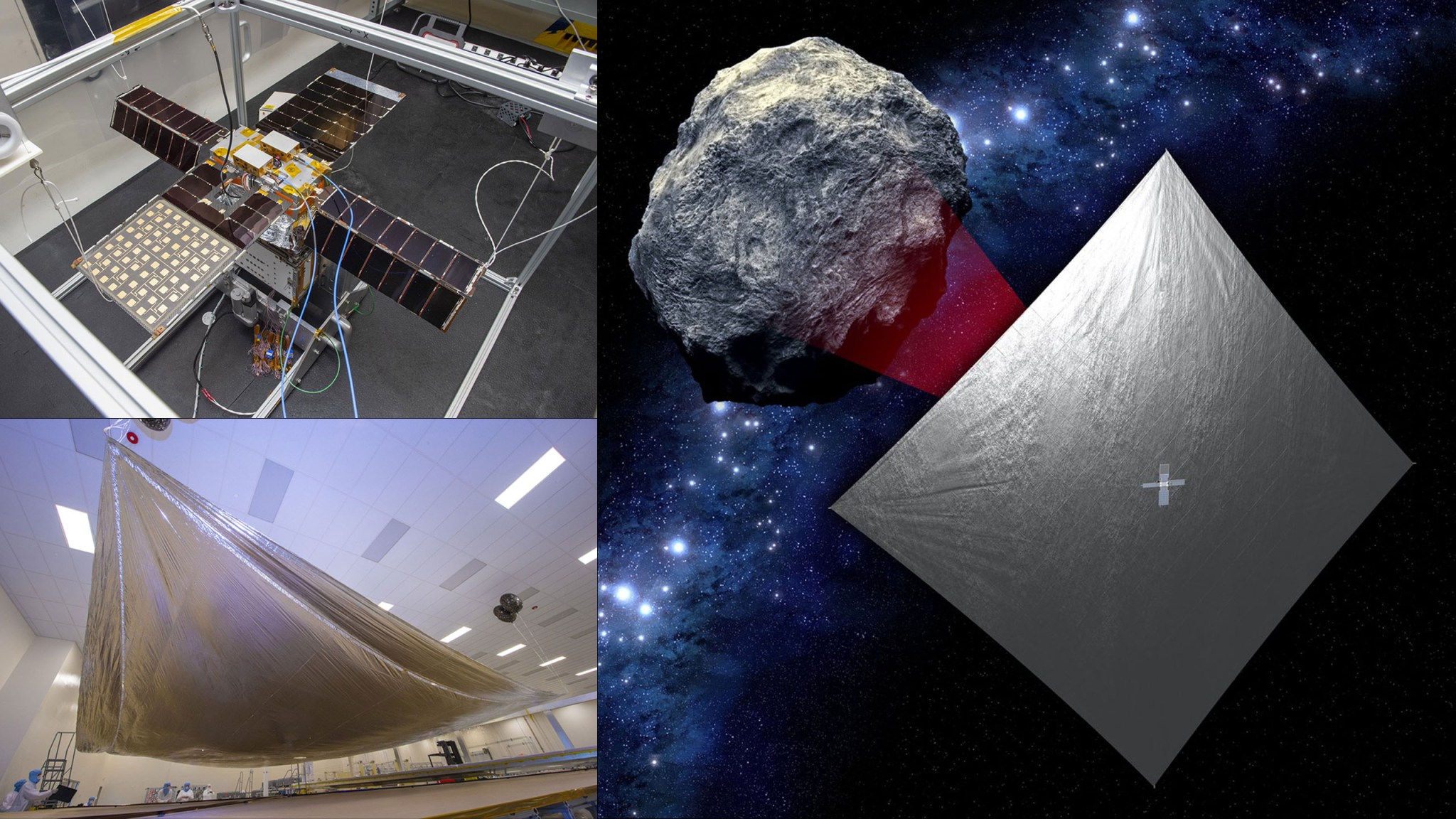
NEA Scout will visit an asteroid estimated to be smaller than a school bus – the smallest asteroid ever to be studied by a spacecraft.
Launching with the Artemis I uncrewed test flight, NASA’s shoebox-size Near-Earth Asteroid Scout will chase down what will become the smallest asteroid ever to be visited by a spacecraft. It will get there by unfurling a solar sail to harness solar radiation for propulsion, making this the agency’s first deep space mission of its kind.
The target is 2020 GE, a near-Earth asteroid (NEA) that is less than 60 feet (18 meters) in size. Asteroids smaller than 330 feet (100 meters) across have never been explored up close before. The spacecraft will use its science camera to get a closer look, measuring the object’s size, shape, rotation, and surface properties while looking for any dust and debris that might surround 2020 GE.
Because the camera has a resolution of less than 4 inches (10 centimeters) per pixel, the mission’s science team will be able to determine whether 2020 GE is solid – like a boulder – or if it’s composed of smaller rocks and dust clumped together like some of its larger asteroid cousins, such as asteroid Bennu.
“Thanks to the discoveries of NEAs by Earth-based observatories, several targets had been identified for NEA Scout, all within the 16-to-100-foot [5-to-30-meter] size range,” said Julie Castillo-Rogez, the mission’s principal science investigator at NASA’s Jet Propulsion Laboratory in Southern California. “2020 GE represents a class of asteroid that we currently know very little about.”
2020 GE was first observed on March 12, 2020, by the University of Arizona’s Catalina Sky Survey as part of its search for near-Earth objects for NASA’s Planetary Defense Coordination Office.
Developed under NASA’s Advanced Exploration Systems Division by Marshall Space Flight Center in Huntsville, Alabama, and JPL, NEA Scout is a science and technology demonstration mission that will enhance the agency’s understanding of small NEAs. Using a six-unit CubeSat form factor, it will ride as one of 10 secondary payloads aboard the powerful Space Launch System (SLS) rocket, which will launch no earlier than March 2022 at NASA’s Kennedy Space Center in Florida. NEA Scout will then be deployed from a dispenser attached to the adapter ring that connects the rocket and Orion spacecraft.
The mission will act as a nimble scout for future human and robotic missions that may utilize asteroid resources – and will gain important planetary defense insights about this class of NEA.
Fully interactive, Eyes on Asteroids uses science data to help visualize asteroid and comet orbits around the Sun. Zoom in to travel along with your favorite spacecraft as it explores these fascinating near-Earth objects. Credit: NASA/JPL-Caltech
“Although large asteroids are of most concern from a planetary defense perspective, objects like 2020 GE are far more common and can pose a hazard to our planet, despite their smaller size,” said Castillo-Rogez. The Chelyabinsk meteor was caused by a small asteroid about 65 feet (20 meters) in diameter – it exploded over the Russian city on Feb. 15, 2013, creating a shockwave that broke windows all over the city and injured more than 1,600 people. That was the same class of NEA as 2020 GE.
Low Mass, High Performance
Learning more about asteroid 2020 GE is only part of NEA Scout’s job. It will also demonstrate solar sail technology for deep space encounters. When released from its dispenser after launch, the spacecraft will use stainless steel alloy booms to unfurl a solar sail that will expand from a small package to a sail about the size of a racquetball court, or 925 square feet (86 square meters).
Made from plastic-coated aluminum thinner than a human hair, this lightweight, mirror-like sail will generate thrust by reflecting solar photons – quantum particles of light radiating from the Sun. The sail will provide most of NEA Scout’s propulsion, but small cold-gas thrusters with a limited propellant supply will also assist with maneuvers and orientation.
“The genesis of this project was a question: Can we really use a tiny spacecraft to do deep space missions and produce useful science at a low cost?” said Les Johnson, the mission’s principal technology investigator at Marshall. “This is a huge challenge. For asteroid characterization missions, there’s simply not enough room on a CubeSat for large propulsion systems and the fuel they require.”
Sunlight acts as a constant force, so a tiny spacecraft equipped with a large solar sail can eventually travel many miles per second. Solar sails are a high-performance propulsion system for low-mass and low-volume spacecraft, according to Johnson. NEA Scout will maneuver by tipping and tilting its sail to change the angle of sunlight, altering the amount of thrust and direction of travel, similar to how a boat uses the wind to sail.
In September 2023, asteroid 2020 GE will make a close approach with Earth, and with a gravitational assist from the Moon, NEA Scout will have gathered enough speed to catch up. Mission navigators will fine-tune NEA Scout’s trajectory before the spacecraft approaches within a mile of the asteroid.
“NEA Scout will accomplish probably the slowest flyby of an asteroid ever – at a relative speed of less than 100 feet [30 meters] per second,” said Castillo-Rogez. “This will give us a few hours to gather invaluable science and allow us to see what asteroids of this class look like up close.”
NEA Scout sets the stage for future solar sails: NASA’s Advanced Composite Solar Sail System will demonstrate novel, lightweight booms to deploy a solar sail from a CubeSat following its 2022 launch. After that, Solar Cruiser, an 18,000-square-foot (nearly 1,700-square-meter) solar sail technology demonstration, will use sunlight to travel toward the Sun in 2025, enabling future missions to better monitor space weather.
For more about the NEA Scout mission, visit:
https://www.nasa.gov/content/nea-scout
Ian J. O’Neill
Jet Propulsion Laboratory, Pasadena, Calif.
818-354-2649
ian.j.oneill@jpl.nasa.gov
Molly Porter
Marshall Space Flight Center, Huntsville, Ala.
256-424-5158
molly.a.porter@nasa.gov
2022-005




























